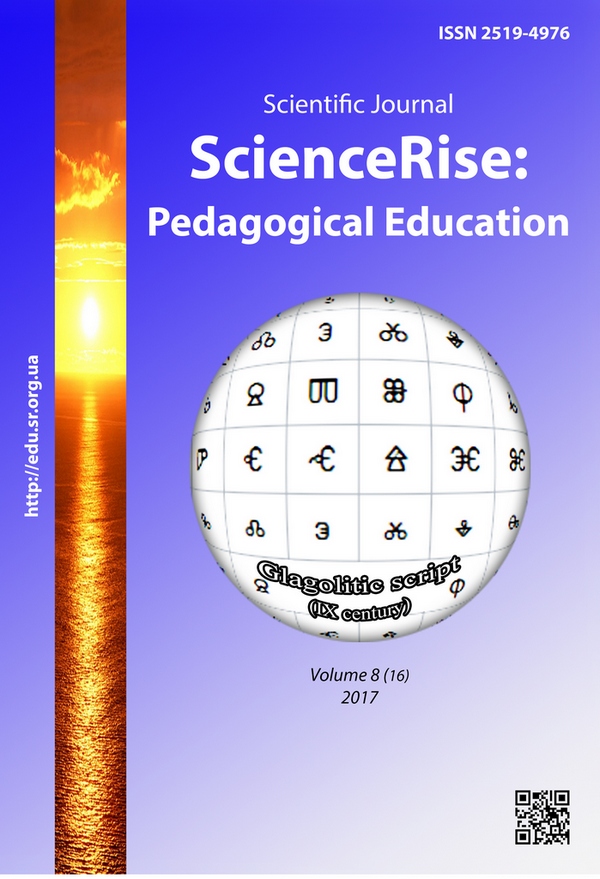Побудова альтернативної системи рейтингування наукової активності вищих навчальних закладів України: методичні засади та результати апробації
DOI:
https://doi.org/10.15587/2519-4984.2017.109316Ключові слова:
ВНЗ, наукова активність, рейтинг, індикативний простір, інтегральний показник, кластерний аналізАнотація
Стаття присвячена розробці альтернативної системи рейтингування наукової активності вищих навчальних закладів (ВНЗ) України. Структура системи містить два рівні: рівень формування однорідних за ступенем наукової продуктивності кластерів ВНЗ та рівень визначення рейтингової позиції ВНЗ по кожному кластеру. Відмінністю запропонованої рейтингової системи є використання обґрунтованого переліку відносних показників в якості індикаторів рейтингового оцінювання, що дозволяє елімінувати ефект «масштабу виробництва» ВНЗ
Посилання
- Ponomarenko, V. S., Raievnieva, O. V. (Eds.) (2011). Intehrovana systema «Vyshcha shkola – biznes-struktura»: metodolohiia ta kontseptualni zasady pobudovy. Kharkiv: VD «INZhEK», 160.
- Kalashnik, S. A., Luhovyi, V. I. (Eds.) (2015). Rozvytok systemy zabezpechennia yakosti vyshchoi osvity v Ukraini: informatsiino-analitychnyi ohliad. Kyiv: DP «NVTs «Priorytety», 84.
- Mykhailichenko, M. V. (2011). Kompetentnistnyi pidkhid do pidhotovky kerivnykiv navchalnykh zakladiv. Vytoky pedahohichnoi maisternosti. Ser.: Pedahohichni nauky, 8 (1), 3–8.
- Valenkevych, L. P., Kravchenko, L. S. (2011). Motyvatsiini metody upravlinnia personalom yak chynnyk pidvyshchennia efektyvnosti roboty vyshchoho navchalnoho zakladu (na prykladi SumDU). Visnyk Sumskoho derzhavnoho universytetu. Seriia Ekonomika, 2, 132–136.
- Sanina, O. R., Kushnir, T. M. (2012). Marketynhovi aspekty reitynhovoi otsinky vyshchykh navchalnykh zakladiv na rynku osvitnikh posluh Ukrainy. Visnyk Natsionalnoho universytetu "Lvivska politekhnika", 739, 283–292.
- Dzoba, O. H. (2014). Vykorystannia reitynhovykh protsedur pry formuvanni modeli upravlinnia vyshchym navchalnym zakladom. Ekonomichnyi chasopys - KhKhI. Naukovyi zhurnal, 3-4 (1), 62–64.
- Demidov, Ya. P. (2013). Teoriya i praktika sovremennogo reytingovaniya: kriticheskie zametki. Ekonomicheskiy analiz: teoriya i praktika, 8 (311), 14–19.
- Drach, I. Ye. (2012). Innovatsiino-proektna diialnist u systemi reitynhovoho otsiniuvannia VNZ Ukrainy. Naukovyi visnyk NHU. Seriya: Ekonomika ta upravlinnia, 5, 126–131.
- Sherega, F. E., Arefyev, A. L. (Eds.) (2014). Rating THE of higher education institutions of BRIKS countries and countries with rising economy. Digest. Measurement of universities ratings: an international and Russian experience. Ministry of the Russian Federation education and sciences. Moscow.
- Hazelkorn, E. (2015). Rankings and the Reshaping of Higher Education: The Battle for World-Class Excellence. Palgrave Macmillan UK, 304. doi: 10.1057/9781137446671
- Razrabotka i aprobaciya metodologii reytingovaniya obrazovatel'nyh uchrezhdeniy professional'nogo obrazovaniya. Available at: http://ranking.ntf.ru/
- Reytingovanie universitetov (2013). Otechestvennye zapiski, 4 (55). Available at: http://strana-oz.ru/2013/4/reytingovanie-universitetov
- Van Raan, A. F. J. (2005). Fatal attraction: Conceptual and methodological problems in the ranking of universities by bibliometric methods. Scientometrics, 62 (1), 133–143. doi: 10.1007/s11192-005-0008-6
- Ioannidis, J. P., Patsopoulos, N. A., Kavvoura, F. K., Tatsioni, A., Evangelou, E., Kouri, I. et. al. (2007). International ranking systems for universities and institutions: a critical appraisal. BMC Medicine, 5 (1). doi: 10.1186/1741-7015-5-30
- Billaut, J.-C., Bouyssou, D., Vincke, P. (2009). Should you believe in the Shanghai ranking? Scientometrics, 84 (1), 237–263. doi: 10.1007/s11192-009-0115-x
- Waltman, L., Calero-Medina, C., Kosten, J., Noyons, E. C. M., Tijssen, R. J. W., van Eck, N. J. et. al. (2012). The Leiden ranking 2011/2012: Data collection, indicators, and interpretation. Journal of the American Society for Information Science and Technology, 63 (12), 2419–2432. doi: 10.1002/asi.22708
- Veljko, J., Marković, A., Bulajić, M.; Jakšić, M. L., Rakočević, S. B. (Eds.) (2012). A Critical Assessment of International University Ranking System. Proceedings of the XIII International Symposium SymOrg 2012: Innovative Management and Business Performance, 554–559.
- Paruolo, P., Saisana, M., Saltelli, A. (2012). Ratings and rankings: voodoo or science? Journal of the Royal Statistical Society: Series A (Statistics in Society), 176 (3), 609–634. doi: 10.1111/j.1467-985x.2012.01059.x
- Billaut, J.-C., Bouyssou, D., Vincke, P. (2009). Should you believe in the Shanghai ranking? Scientometrics, 84 (1), 237–263. doi: 10.1007/s11192-009-0115-x
- Ward, J. H. (1963). Hierarchical Grouping to Optimize an Objective Function. Journal of the American Statistical Association, 58 (301), 236–244. doi: 10.1080/01621459.1963.10500845
- Plyuta, V. (1989). Sravnitel'nyy mnogomernyy analiz v ekonometricheskom modelirovanii. Moscow: Finansy i statistika, 173.
##submission.downloads##
Опубліковано
Як цитувати
Номер
Розділ
Ліцензія
Авторське право (c) 2017 Olena Rayevnyeva, Svitlana Stepurina

Ця робота ліцензується відповідно до Creative Commons Attribution 4.0 International License.
Наше видання використовує положення про авторські права Creative Commons CC BY для журналів відкритого доступу.
Автори, які публікуються у цьому журналі, погоджуються з наступними умовами:
1. Автори залишають за собою право на авторство своєї роботи та передають журналу право першої публікації цієї роботи на умовах ліцензії Creative Commons CC BY, котра дозволяє іншим особам вільно розповсюджувати опубліковану роботу з обов'язковим посиланням на авторів оригінальної роботи та першу публікацію роботи у цьому журналі.
2. Автори мають право укладати самостійні додаткові угоди щодо неексклюзивного розповсюдження роботи у тому вигляді, в якому вона була опублікована цим журналом (наприклад, розміщувати роботу в електронному сховищі установи або публікувати у складі монографії), за умови збереження посилання на першу публікацію роботи у цьому журналі.









